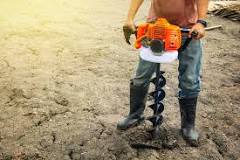An auger is a powerful drilling tool that is commonly used for drilling holes in the ground for various purposes such as planting trees, fence posts, or installing foundation supports.
Will an auger be able to penetrate through rock? The answer to this question is not a straightforward one, and it depends on several factors. In this blog post, we will explore the factors that determine whether an auger can go through rock and what alternatives are available.

Types of Augers
There are several types of augers available, including hand augers, power augers, and hydraulic augers. Hand augers are typically used for light-duty drilling applications, while power and hydraulic augers are better suited for heavy-duty work. In terms of drilling through rock, hydraulic augers are generally the most effective, as they have the power to drill through tough rock formations.
Carbide-Tipped Augers
One type of auger that is particularly effective for drilling through rock is the carbide-tipped auger. These augers have a special carbide tip that is designed to cut through rock formations, making them ideal for drilling in rocky terrain. Carbide-tipped augers are commonly used for geotechnical drilling, environmental drilling, and mining applications.
Diamond-Tipped Augers
Diamond-tipped augers are another type of auger that can be effective for drilling through rock. These augers have a diamond-encrusted tip that is designed to grind through rock formations. Diamond-tipped augers are often used in the mining industry and for geotechnical drilling.
Limitations of Augers
While augers can be effective for drilling through rock, there are some limitations to consider. For example, the type of rock can greatly impact the effectiveness of the auger. Soft rock formations such as sandstone may be easier to drill through than hard rock formations such as granite. Additionally, the size of the rock and the depth of the hole can also impact the effectiveness of the auger.
Overall, An auger can go through rock, but the type of auger you choose and the type of rock you are drilling through can greatly impact its effectiveness.
The Impact of Rock Hardness on Auger Performance
When it comes to using an auger for drilling, one of the factors that can significantly impact its performance is the hardness of the rock. While an auger can make quick work of softer materials such as soil, it may struggle when confronted with tougher, more resilient rock types.
The hardness of rock is typically measured using the Mohs scale, which ranks minerals on a scale of 1 to 10, with 1 being the softest and 10 being the hardest. For example, shale and sandstone have a hardness rating of 3 to 4, while granite and basalt are some of the hardest rocks with a rating of 6 to 7.
When drilling through rock, an auger’s effectiveness is determined by how well it can break through the material. For softer rocks, an auger may be able to penetrate and bore through with relative ease. However, with harder rocks, an auger may struggle to make any significant progress and may even become damaged in the process.
It’s important to note that the performance of an auger can also be affected by factors such as the type of cutting head used, the size and design of the auger, and the power of the drilling equipment. In some cases, it may be necessary to use specialized equipment or techniques to drill through particularly hard rock formations.
Choosing the Right Size and Power of Auger for Drilling through Rock
Choosing the right size and power of auger is crucial when it comes to drilling through rock.
If the auger is too small or lacks sufficient power, it may struggle to penetrate the rock, resulting in time-consuming and potentially costly delays.
On the other hand, if the auger is too large or powerful, it may be difficult to control, increasing the risk of injury or damage to equipment.
Augers come in various sizes, ranging from handheld models to large-scale machines designed for commercial use. The size of the auger needed will depend on the size of the hole required and the type of rock being drilled.
In general, larger augers are better suited for drilling through harder and larger rocks, while smaller augers are suitable for softer and smaller rocks.
In addition to size, the power of the auger is also a critical consideration. Augers come in both gas-powered and electric-powered models, and the power output can vary significantly between models. More powerful augers are better suited for drilling through harder and larger rocks, while less powerful augers are suitable for softer and smaller rocks.
Generally, larger augers have more power and torque and are better suited for drilling through hard surfaces such as rock. However, larger augers may also require more power and a larger drill rig, which can increase the cost of the project.
It is important to note that even the most powerful augers may struggle with drilling through exceptionally hard rock. In such cases, users may need to consider alternative methods, such as using a jackhammer or hiring specialized drilling equipment.

Tips for Drilling Through Rock with an Auger
Pre-drilling
Pre-drilling involves using a smaller drill bit to create a pilot hole in the rock before using the auger. This can help to guide the auger and prevent it from wandering off course, which can be particularly helpful when drilling through harder types of rock.
Using a Rock Auger
A rock auger is specifically designed for drilling through rock and has a more aggressive cutting structure than a standard auger. Rock augers are typically made from high-strength steel and are available in a variety of sizes to accommodate different types of drilling equipment.
Applying Pressure
Applying pressure to the auger can help to improve its penetration into the rock. This can be done by increasing the hydraulic pressure of the drilling equipment or by manually pushing down on the auger as it rotates.
Using Water
Injecting water into the pilot hole or onto the cutting surface of the auger can help to cool the rock and prevent the bit from becoming overheated. Water can also help to lubricate the bit and improve its cutting performance.
Adjusting the Angle
The angle at which the auger is positioned can also impact its ability to drill through rock. For harder types of rock, it may be necessary to adjust the angle of the auger to ensure that it is drilling straight down rather than at an angle.
Auger Alternatives
If an auger cannot penetrate through rock, there are several alternative methods that can be used, including blasting, rock drilling, and excavation. Blasting involves using explosives to break up the rock, while rock drilling uses specialized equipment to drill through solid rock. Excavation involves removing the rock entirely using excavation equipment.
These methods are typically more expensive and time-consuming than using an auger, but they may be necessary depending on the size and hardness of the rock.
Safety Precautions
Wear Protective Gear
Before beginning any drilling operation, it is important to wear the appropriate protective gear. This may include safety glasses, gloves, earplugs, and a hard hat. It is also important to wear non-slip footwear with good traction to prevent slips and falls.
Inspect the Site
Before drilling, it is important to inspect the site thoroughly. Look for any potential hazards such as loose rocks, unstable ground, or underground utilities. Make sure the area is clear of debris and that there is enough space to safely operate the auger.
Use the Right Equipment
Using the right equipment is crucial for safety when drilling through rock with an auger. Make sure the auger is the appropriate size and power for the job and that it is in good working condition. Inspect the blades and replace any that are dull or damaged.
Follow the Manufacturer’s Instructions
Always follow the manufacturer’s instructions when operating an auger. This includes starting and stopping procedures, as well as any safety precautions specific to your auger model. Do not attempt to modify or alter the auger in any way.
Beware of Overhead Power Lines
When drilling through rock, it is important to be aware of overhead power lines. Contact with power lines can be fatal, so make sure to keep the auger at a safe distance from power lines at all times. If the job site is near power lines, contact the utility company to mark the lines and provide guidance on safe operating distances.
FAQs
What Happens When Auger Hits Rock?
Can You Auger Through Rocky Soil?
Can You Auger Through Gravel?
What Is the Best Way to Dig Through Rock?
Conclusion
Drilling through rock with an auger can be a challenging task, but it is possible with the right equipment, techniques, and safety precautions. The ability of an auger to penetrate rock depends on several factors, including the type and hardness of the rock, the size and power of the auger, and the drilling technique used.
When attempting to drill through rock with an auger, it is important to take the necessary safety precautions to avoid injury or damage to equipment. By following the proper procedures, it is possible to successfully drill through rock with an auger.






